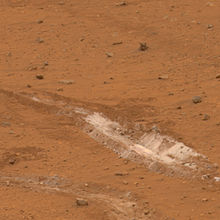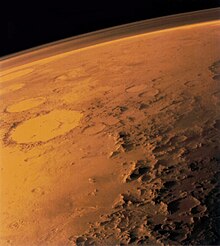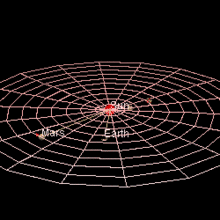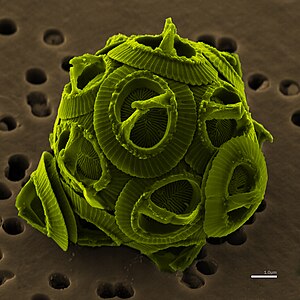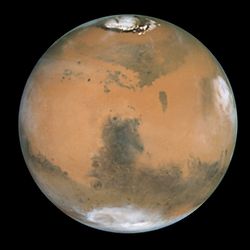 Mars is the fourth planet from the Sun in the Solar System. Named after the Roman god of war, it is often described as the "Red Planet", as the iron oxide prevalent on its surface gives it a reddish appearance.[14] Mars is a terrestrial planet with a thin atmosphere, having surface features reminiscent both of the impact craters of the Moon and the volcanoes, valleys, deserts, and polar ice caps of Earth. The rotational period
and seasonal cycles of Mars are likewise similar to those of Earth, as
is the tilt that produces the seasons. Mars is the site of Olympus Mons, the highest known mountain within the Solar System, and of Valles Marineris, one of the largest canyons. The smooth Borealis basin in the northern hemisphere covers 40% of the planet and may be a giant impact feature.[15][16] Mars has two moons, Phobos and Deimos, which are small and irregularly shaped. These may be captured asteroids, similar to 5261 Eureka, a Martian trojan asteroid.
Mars is the fourth planet from the Sun in the Solar System. Named after the Roman god of war, it is often described as the "Red Planet", as the iron oxide prevalent on its surface gives it a reddish appearance.[14] Mars is a terrestrial planet with a thin atmosphere, having surface features reminiscent both of the impact craters of the Moon and the volcanoes, valleys, deserts, and polar ice caps of Earth. The rotational period
and seasonal cycles of Mars are likewise similar to those of Earth, as
is the tilt that produces the seasons. Mars is the site of Olympus Mons, the highest known mountain within the Solar System, and of Valles Marineris, one of the largest canyons. The smooth Borealis basin in the northern hemisphere covers 40% of the planet and may be a giant impact feature.[15][16] Mars has two moons, Phobos and Deimos, which are small and irregularly shaped. These may be captured asteroids, similar to 5261 Eureka, a Martian trojan asteroid.Until the first successful flyby of Mars occurred in 1965 by Mariner 4, many speculated about the presence of liquid water on the planet's surface. This was based on observed periodic variations in light and dark patches, particularly in the polar latitudes, which appeared to be seas and continents; long, dark striations were interpreted by some as irrigation channels for liquid water. These straight line features were later explained as optical illusions, though geological evidence gathered by unmanned missions suggest that Mars once had large-scale water coverage on its surface.[17] In 2005, radar data revealed the presence of large quantities of water ice at the poles[18] and at mid-latitudes.[19][20] The Mars rover Spirit sampled chemical compounds containing water molecules in March 2007. The Phoenix lander directly sampled water ice in shallow Martian soil on July 31, 2008.[21]
Mars is currently host to five functioning spacecraft: three in orbit—the Mars Odyssey, Mars Express, and Mars Reconnaissance Orbiter; and two on the surface—Mars Exploration Rover Opportunity and the Mars Science Laboratory Curiosity. Defunct spacecraft on the surface include MER-A Spirit, and several other inert landers and rovers, both successful and unsuccessful, such as the Phoenix lander, which completed its mission in 2008. Observations by NASA's now-defunct Mars Global Surveyor show evidence that parts of the southern polar ice cap have been receding.[22] Observations by the Mars Reconnaissance Orbiter have revealed possible flowing water during the warmest months on Mars.[23]
Mars can easily be seen from Earth with the naked eye. Its apparent magnitude reaches −3.0,[7] which is only surpassed by Jupiter, Venus, the Moon, and the Sun. Optical ground-based telescopes are typically limited to resolving features about 300 km (186 miles) across when Earth and Mars are closest, because of Earth's atmosphere.
Physical characteristics
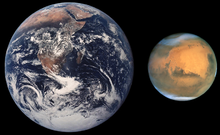
Size comparison of Earth and Mars.
Internal structure
Like Earth, this planet has undergone differentiation, resulting in a dense, metallic core region overlaid by less dense materials.[27] Current models of the planet's interior imply a core region about 1794 ± 65 km in radius, consisting primarily of iron and nickel with about 16–17% sulfur.[28] This iron sulfide core is partially fluid, and has twice the concentration of the lighter elements that exist at Earth's core. The core is surrounded by a silicate mantle that formed many of the tectonic and volcanic features on the planet, but now appears to be dormant. Besides silicon and oxygen, the most abundant elements in the martian crust are iron, magnesium, aluminum, calcium, and potassium. The average thickness of the planet's crust is about 50 km, with a maximum thickness of 125 km.[29] Earth's crust, averaging 40 km, is only one third as thick as Mars's crust, relative to the sizes of the two planets. The InSight lander planned for 2016 will use a seismometer to better constrain the models of the interior.Surface geology
Main article: Geology of Mars

Global mosaic of Mars from data gathered by the Viking 1 orbiter in 1980, showing the Valles Marineris (center)
Although Mars has no evidence of a current structured global magnetic field,[34] observations show that parts of the planet's crust have been magnetized, and that alternating polarity reversals of its dipole field have occurred in the past. This paleomagnetism of magnetically susceptible minerals has properties that are very similar to the alternating bands found on the ocean floors of Earth. One theory, published in 1999 and re-examined in October 2005 (with the help of the Mars Global Surveyor), is that these bands demonstrate plate tectonics on Mars four billion years ago, before the planetary dynamo ceased to function and the planet's magnetic field faded away.[35]
During the Solar System's formation, Mars was created as the result of a stochastic process of run-away accretion out of the protoplanetary disk that orbited the Sun. Mars has many distinctive chemical features caused by its position in the Solar System. Elements with comparatively low boiling points such as chlorine, phosphorus and sulphur are much more common on Mars than Earth; these elements were probably removed from areas closer to the Sun by the young star's energetic solar wind.[36]
After the formation of the planets, all were subjected to the so-called "Late Heavy Bombardment". About 60% of the surface of Mars shows a record of impacts from that era,[37][38][39] while much of the remaining surface is probably underlain by immense impact basins caused by those events. There is evidence of an enormous impact basin in the northern hemisphere of Mars, spanning 10,600 km by 8,500 km, or roughly four times larger than the Moon's South Pole – Aitken basin, the largest impact basin yet discovered.[15][16] This theory suggests that Mars was struck by a Pluto-sized body about four billion years ago. The event, thought to be the cause of the Martian hemispheric dichotomy, created the smooth Borealis basin that covers 40% of the planet.[40][41]
The geological history of Mars can be split into many periods, but the following are the three primary periods:[42][43]
- Noachian period (named after Noachis Terra): Formation of the oldest extant surfaces of Mars, 4.5 billion years ago to 3.5 billion years ago. Noachian age surfaces are scarred by many large impact craters. The Tharsis bulge, a volcanic upland, is thought to have formed during this period, with extensive flooding by liquid water late in the period.
- Hesperian period (named after Hesperia Planum): 3.5 billion years ago to 2.9–3.3 billion years ago. The Hesperian period is marked by the formation of extensive lava plains.
- Amazonian period (named after Amazonis Planitia): 2.9–3.3 billion years ago to present. Amazonian regions have few meteorite impact craters, but are otherwise quite varied. Olympus Mons formed during this period, along with lava flows elsewhere on Mars.
Soil
Main article: Martian soil
The Phoenix lander returned data showing Martian soil to be slightly alkaline and containing elements such as magnesium, sodium, potassium and chlorine. These nutrients are found in gardens on Earth, and are necessary for growth of plants.[46] Experiments performed by the Lander showed that the Martian soil has a basic pH of 8.3, and may contain traces of the salt perchlorate.[47][48]Streaks are common across Mars and new ones appear frequently on steep slopes of craters, troughs, and valleys. The streaks are dark at first and get lighter with age. Sometimes, the streaks start in a tiny area which then spread out for hundreds of metres. They have also been seen to follow the edges of boulders and other obstacles in their path. The commonly accepted theories include that they are dark underlying layers of soil revealed after avalanches of bright dust or dust devils.[49] Several explanations have been put forward, some of which involve water or even the growth of organisms.[50][51]
Hydrology
Main article: Water on Mars

Microscopic photo taken by Opportunity showing a gray hematite concretion, indicative of the past presence of liquid water
Large quantities of water ice are thought to be trapped within the thick cryosphere of Mars. Radar data from Mars Express and the Mars Reconnaissance Orbiter show large quantities of water ice both at the poles (July 2005)[18][57] and at mid-latitudes (November 2008).[19] The Phoenix lander directly sampled water ice in shallow Martian soil on July 31, 2008.[21]
Landforms visible on Mars strongly suggest that liquid water has at least at times existed on the planet's surface. Huge linear swathes of scoured ground, known as outflow channels, cut across the surface in around 25 places. These are thought to record erosion which occurred during the catastrophic release of water from subsurface aquifers, though some of these structures have also been hypothesised to result from the action of glaciers or lava.[58][59] The youngest of these channels are thought to have formed as recently as only a few million years ago.[60] Elsewhere, particularly on the oldest areas of the martian surface, finer-scale, dendritic networks of valleys are spread across significant proportions of the landscape. Features of these valleys and their distribution very strongly imply that they were carved by runoff resulting from rain or snow fall in early Mars history. Subsurface water flow and groundwater sapping may play important subsidiary roles in some networks, but precipitation was probably the root cause of the incision in almost all cases.[61]
There are also thousands of features along crater and canyon walls that appear similar to terrestrial gullies. The gullies tend to be in the highlands of the southern hemisphere and to face the Equator; all are poleward of 30° latitude. A number of authors have suggested that their formation process demands the involvement of liquid water, probably from melting ice,[62][63] although others have argued for formation mechanisms involving carbon dioxide frost or the movement of dry dust.[64][65] No partially degraded gullies have formed by weathering and no superimposed impact craters have been observed, indicating that these are very young features, possibly even active today.[63]
Other geological features, such as deltas and alluvial fans preserved in craters, also argue very strongly for warmer, wetter conditions at some interval or intervals in earlier Mars history.[66] Such conditions necessarily require the widespread presence of crater lakes across a large proportion of the surface, for which there is also independent mineralogical, sedimentological and geomorphological evidence.[67] Some authors have even gone so far as to argue that at times in the martian past, much of the low northern plains of the planet were covered with a true ocean hundreds of meters deep, though this remains controversial.[68]
Further evidence that liquid water once existed on the surface of Mars comes from the detection of specific minerals such as hematite and goethite, both of which sometimes form in the presence of water.[69] Some of the evidence believed to indicate ancient water basins and flows has been negated by higher resolution studies by the Mars Reconnaissance Orbiter.[70] In 2004, Opportunity detected the mineral jarosite. This forms only in the presence of acidic water, which demonstrates that water once existed on Mars.[71] More recent evidence for liquid water comes from the finding of the mineral gypsum on the surface by NASA's Mars rover Opportunity in December 2011.[72][73] Additionally, the study leader Francis McCubbin, a planetary scientist at the University of New Mexico in Albuquerque looking at hydroxals in crystalline minerals from Mars states the amount of water in the upper mantle of Mars is equal to or greater than that of Earth at 50–300 parts per million of water, which is enough to cover the entire planet to a depth of 200 to 1000 meters.[74]
Polar caps
Main article: Martian polar ice caps
Mars has two permanent polar ice caps. During a pole's winter, it
lies in continuous darkness, chilling the surface and causing the deposition of 25–30% of the atmosphere into slabs of CO2 ice (dry ice).[75] When the poles are again exposed to sunlight, the frozen CO2 sublimes,
creating enormous winds that sweep off the poles as fast as 400 km/h.
These seasonal actions transport large amounts of dust and water vapor,
giving rise to Earth-like frost and large cirrus clouds. Clouds of water-ice were photographed by the Opportunity rover in 2004.[76]The polar caps at both poles consist primarily of water ice. Frozen carbon dioxide accumulates as a comparatively thin layer about one metre thick on the north cap in the northern winter only, while the south cap has a permanent dry ice cover about eight metres thick.[77] The northern polar cap has a diameter of about 1,000 kilometres during the northern Mars summer,[78] and contains about 1.6 million cubic km of ice, which, if spread evenly on the cap, would be 2 km thick.[79] (This compares to a volume of 2.85 million cubic km (km3) for the Greenland ice sheet.) The southern polar cap has a diameter of 350 km and a thickness of 3 km.[80] The total volume of ice in the south polar cap plus the adjacent layered deposits has also been estimated at 1.6 million cubic km.[81] Both polar caps show spiral troughs, which recent analysis of SHARAD ice penetrating radar has shown are a result of katabatic winds that spiral due to the Coriolis Effect.[82][83]
The seasonal frosting of some areas near the southern ice cap results in the formation of transparent 1 metre thick slabs of dry ice above the ground. With the arrival of spring, sunlight warms the subsurface and pressure from subliming CO2 builds up under a slab, elevating and ultimately rupturing it. This leads to geyser-like eruptions of CO2 gas mixed with dark basaltic sand or dust. This process is rapid, observed happening in the space of a few days, weeks or months, a rate of change rather unusual in geology—especially for Mars. The gas rushing underneath a slab to the site of a geyser carves a spider-like pattern of radial channels under the ice.[84][85][86][87]
Geography
Main article: Geography of Mars
See also: Category:Surface features of Mars
Although better remembered for mapping the Moon, Johann Heinrich Mädler and Wilhelm Beer
were the first "areographers". They began by establishing that most of
Mars's surface features were permanent, and more precisely determining
the planet's rotation period. In 1840, Mädler combined ten years of
observations and drew the first map of Mars. Rather than giving names to
the various markings, Beer and Mädler simply designated them with
letters; Meridian Bay (Sinus Meridiani) was thus feature "a".[88]Today, features on Mars are named from a variety of sources. Albedo features are named for classical mythology. Craters larger than 60 kilometres (37 mi) are named for deceased scientists and writers and others who have contributed to the study of Mars. Craters smaller than 60 km are named for towns and villages of the world with populations of less than 100,000. Large valleys are named for the word mars or star in various languages, small valleys are named for rivers.[89]
Large albedo features retain many of the older names, but are often updated to reflect new knowledge of the nature of the features. For example, Nix Olympica (the snows of Olympus) has become Olympus Mons (Mount Olympus).[90] The surface of Mars as seen from Earth is divided into two kinds of areas, with differing albedo. The paler plains covered with dust and sand rich in reddish iron oxides were once thought of as Martian "continents" and given names like Arabia Terra (land of Arabia) or Amazonis Planitia (Amazonian plain). The dark features were thought to be seas, hence their names Mare Erythraeum, Mare Sirenum and Aurorae Sinus. The largest dark feature seen from Earth is Syrtis Major Planum.[91] The permanent northern polar ice cap is named Planum Boreum, while the southern cap is called Planum Australe.
Mars's equator is defined by its rotation, but the location of its Prime Meridian was specified, as was Earth's (at Greenwich), by choice of an arbitrary point; Mädler and Beer selected a line in 1830 for their first maps of Mars. After the spacecraft Mariner 9 provided extensive imagery of Mars in 1972, a small crater (later called Airy-0), located in the Sinus Meridiani ("Middle Bay" or "Meridian Bay"), was chosen for the definition of 0.0° longitude to coincide with the original selection.[92]
Since Mars has no oceans and hence no "sea level", a zero-elevation surface also had to be selected as a reference level; this is also called the areoid[93] of Mars, analogous to the terrestrial geoid. Zero altitude was defined by the height at which there is 610.5 Pa (6.105 mbar) of atmospheric pressure.[94] This pressure corresponds to the triple point of water, and is about 0.6% of the sea level surface pressure on Earth (0.006 atm).[95] In practice, today this surface is defined directly from satellite gravity measurements.
Impact topography

Panorama of Gusev crater, where Spirit rover examined volcanic basalts
Mars is scarred by a number of impact craters: a total of 43,000 craters with a diameter of 5 km or greater have been found.[96] The largest confirmed of these is the Hellas impact basin, a light albedo feature clearly visible from Earth.[97] Due to the smaller mass of Mars, the probability of an object colliding with the planet is about half that of the Earth. Mars is located closer to the asteroid belt, so it has an increased chance of being struck by materials from that source. Mars is also more likely to be struck by short-period comets, i.e. those that lie within the orbit of Jupiter.[98] In spite of this, there are far fewer craters on Mars compared with the Moon, because the atmosphere of Mars provides protection against small meteors. Some craters have a morphology that suggests the ground became wet after the meteor impacted.[99]
Volcanoes
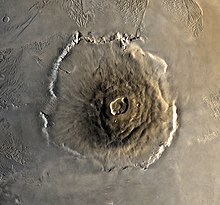
Top down view of Olympus Mons, the highest known mountain in the solar system
Main article: Volcanism on Mars
The shield volcano, Olympus Mons (Mount Olympus), at 27 km is the highest known mountain in the Solar System.[100] It is an extinct volcano in the vast upland region Tharsis, which contains several other large volcanoes. Olympus Mons is over three times the height of Mount Everest, which in comparison stands at just over 8.8 km.[101]Tectonic sites
The large canyon, Valles Marineris (Latin for Mariner Valleys, also known as Agathadaemon in the old canal maps), has a length of 4,000 km and a depth of up to 7 km. The length of Valles Marineris is equivalent to the length of Europe and extends across one-fifth the circumference of Mars. By comparison, the Grand Canyon on Earth is only 446 km long and nearly 2 km deep. Valles Marineris was formed due to the swelling of the Tharsis area which caused the crust in the area of Valles Marineris to collapse. Another large canyon is Ma'adim Vallis (Ma'adim is Hebrew for Mars). It is 700 km long and again much bigger than the Grand Canyon with a width of 20 km and a depth of 2 km in some places. It is possible that Ma'adim Vallis was flooded with liquid water in the past.[102] In 2012, plate tectonics are reported to occur on Mars.[103]Caves

THEMIS
image of probable Mars cave entrances, informally named (A) Dena, (B)
Chloe, (C) Wendy, (D) Annie, (E) Abby (left) and Nikki, and (F) Jeanne.
Atmosphere
Main article: Atmosphere of Mars
Mars lost its magnetosphere 4 billion years ago,[107] so the solar wind interacts directly with the Martian ionosphere, lowering the atmospheric density by stripping away atoms from the outer layer. Both Mars Global Surveyor and Mars Express have detected ionised atmospheric particles trailing off into space behind Mars,[107][108] and this atmospheric loss will be studied by the upcoming MAVEN orbiter. Compared to Earth, the atmosphere of Mars is quite rarefied. Atmospheric pressure on the surface today ranges from a low of 30 Pa (0.030 kPa) on Olympus Mons to over 1,155 Pa (1.155 kPa) in the Hellas Planitia, with a mean pressure at the surface level of 600 Pa (0.60 kPa).[109] The highest atmospheric density on Mars is equal to the density found 35 km[110] above the Earth's surface. The resulting maximum surface pressure is only 0.6% of that of the Earth (101.3 kPa). The scale height of the atmosphere is about 10.8 km,[111]
which is higher than Earth's (6 km) because the surface gravity of Mars
is only about 38% of Earth's, an effect offset by both the lower
temperature and 50% higher average molecular weight of the atmosphere of
Mars.The atmosphere of Mars consists of about 95% carbon dioxide, 3% nitrogen, 1.6% argon and contains traces of oxygen and water.[6] The atmosphere is quite dusty, containing particulates about 1.5 µm in diameter which give the Martian sky a tawny color when seen from the surface.[112]
Methane has been detected in the Martian atmosphere with a mole fraction of about 30 ppb;[12][113] it occurs in extended plumes, and the profiles imply that the methane was released from discrete regions. In northern midsummer, the principal plume contained 19,000 metric tons of methane, with an estimated source strength of 0.6 kilogram per second.[114][115] The profiles suggest that there may be two local source regions, the first centered near 30° N, 260° W and the second near 0°, 310° W.[114] It is estimated that Mars must produce 270 ton/year of methane.[114][116]
The implied methane destruction lifetime may be as long as about 4 Earth years and as short as about 0.6 Earth years.[114][117] This rapid turnover would indicate an active source of the gas on the planet. Volcanic activity, cometary impacts, and the presence of methanogenic microbial life forms are among possible sources. Methane could also be produced by a non-biological process called serpentinization[b] involving water, carbon dioxide, and the mineral olivine, which is known to be common on Mars.[118]
Ammonia was also tentatively detected on Mars by the Mars Express satellite, but with its relatively short lifetime, it is not clear what produced it.[119] Ammonia is not stable there and breaks down after a few hours, so one possible source is volcanic activity.[119]
Climate
Main article: Climate of Mars
Of all the planets in the Solar System, the seasons of Mars are the
most Earth-like, due to the similar tilts of the two planets' rotational
axes. The lengths of the Martian seasons are about twice those of
Earth's, as Mars's greater distance from the Sun leads to the Martian
year being about two Earth years long. Martian surface temperatures vary
from lows of about −143 °C (−225 °F) (at the winter polar caps)[8] to highs of up to 35 °C (95 °F) (in equatorial summer).[9]
The wide range in temperatures is due to the thin atmosphere which
cannot store much solar heat, the low atmospheric pressure, and the low thermal inertia of Martian soil.[120] The planet is also 1.52 times as far from the sun as Earth, resulting in just 43% of the amount of sunlight.[121]If Mars had an Earth-like orbit, its seasons would be similar to Earth's because its axial tilt is similar to Earth's. The comparatively large eccentricity of the Martian orbit has a significant effect. Mars is near perihelion when it is summer in the southern hemisphere and winter in the north, and near aphelion when it is winter in the southern hemisphere and summer in the north. As a result, the seasons in the southern hemisphere are more extreme and the seasons in the northern are milder than would otherwise be the case. The summer temperatures in the south can reach up to 30 °C (54.0 °F) warmer than the equivalent summer temperatures in the north.[122]
Mars also has the largest dust storms in our Solar System. These can vary from a storm over a small area, to gigantic storms that cover the entire planet. They tend to occur when Mars is closest to the Sun, and have been shown to increase the global temperature.[123]
Orbit and rotation
The axial tilt of Mars is 25.19 degrees, which is similar to the axial tilt of the Earth.[6] As a result, Mars has seasons like the Earth, though on Mars, they are nearly twice as long given its longer year. Currently, the orientation of the north pole of Mars is close to the star Deneb.[13] Mars passed an aphelion in March 2010[124] and its perihelion in March 2011.[125] The next aphelion came in February 2012[125] and the next perihelion comes in January 2013.[125]
Mars has a relatively pronounced orbital eccentricity of about 0.09; of the seven other planets in the Solar System, only Mercury shows greater eccentricity. It is known that in the past, Mars has had a much more circular orbit than it does currently. At one point, 1.35 million Earth years ago, Mars had an eccentricity of roughly 0.002, much less than that of Earth today.[126] The Mars cycle of eccentricity is 96,000 Earth years compared to the Earth's cycle of 100,000 years.[127] Mars also has a much longer cycle of eccentricity with a period of 2.2 million Earth years, and this overshadows the 96,000-year cycle in the eccentricity graphs. For the last 35,000 years, the orbit of Mars has been getting slightly more eccentric because of the gravitational effects of the other planets. The closest distance between the Earth and Mars will continue to mildly decrease for the next 25,000 years.[128]
Images comparing Mars's orbit with Ceres, a dwarf planet in the asteroid belt. The left is shown from the north ecliptic
pole. The right is shown from the ascending node. The segments of
orbits south of the ecliptic are plotted in darker colors. The perihelia (q) and aphelia (Q) are labelled with the date of nearest passage. The orbit of Mars is red, Ceres is yellow.
